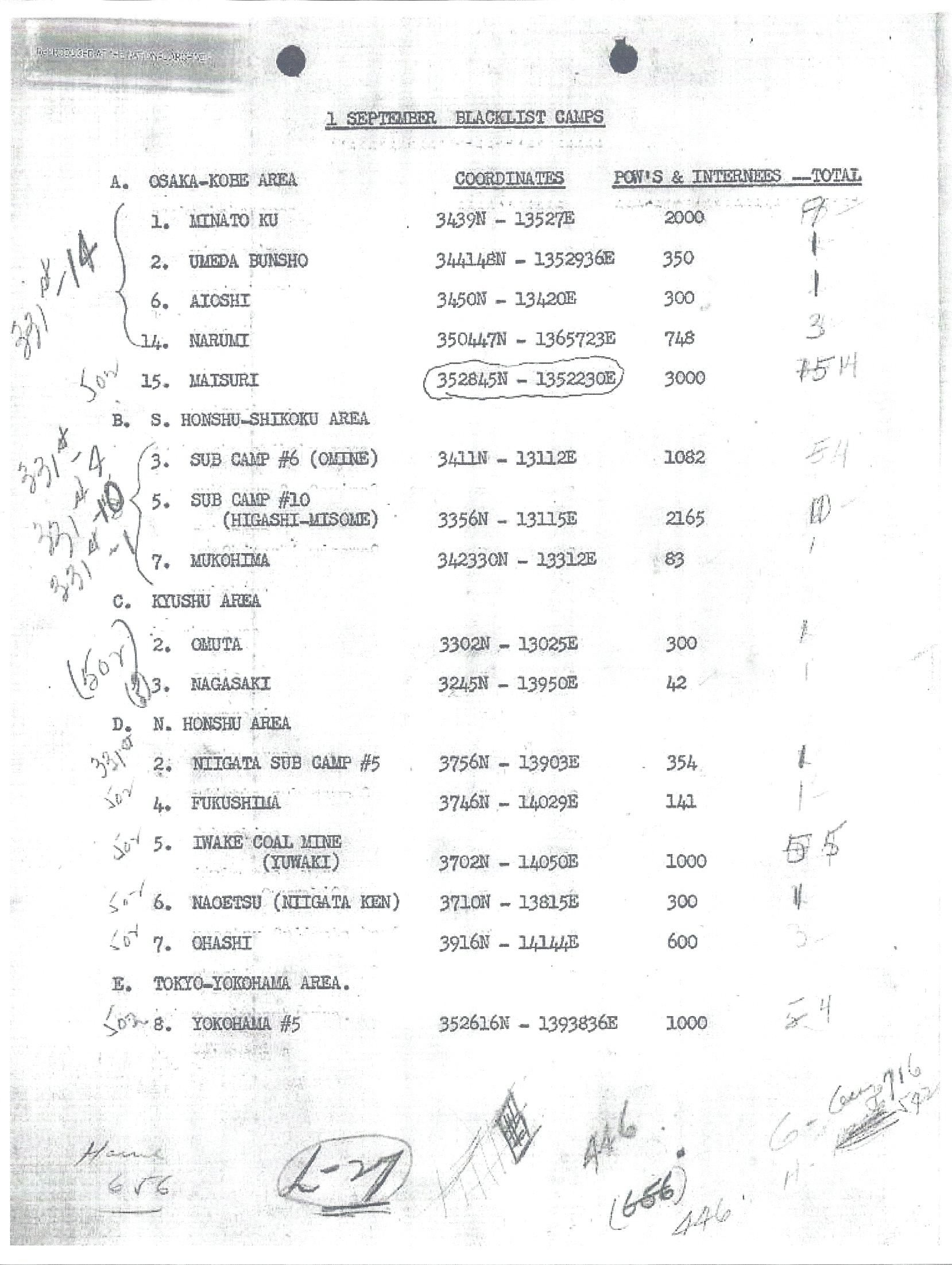
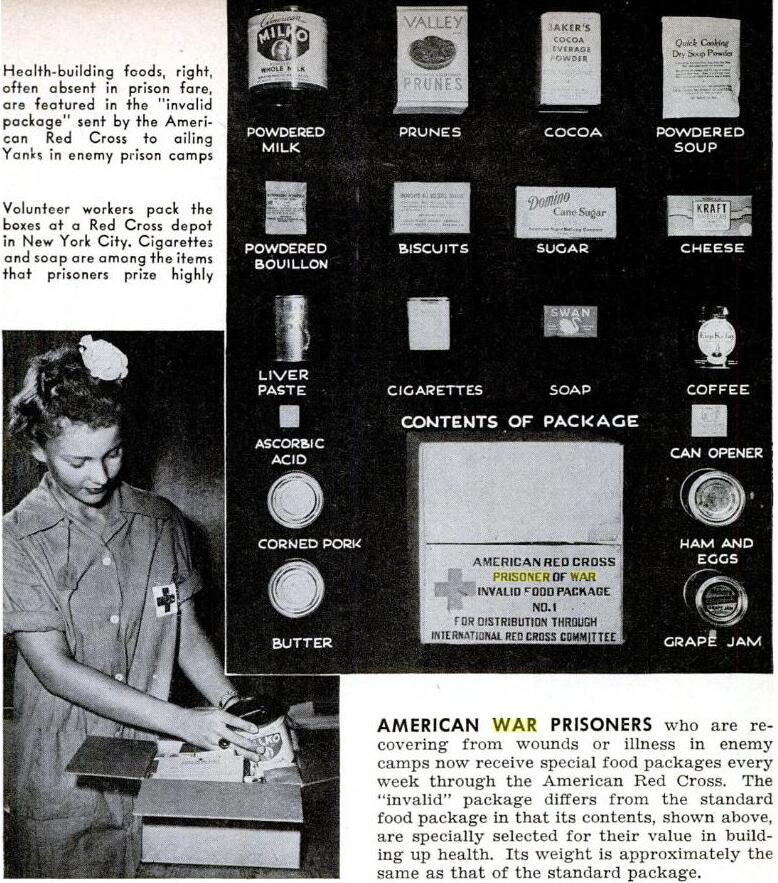
The
Liberation of POW's
|
| Main | About Us |
| From
late December 1942, the International Red Cross
sought to determine the exact location of Allied POW's held by the
Japanese. This information was then used to plan official visits to the
camps to determine the condition of the POW's and their needs.
Consequently, from March through August 1942, the IRC first
visited
four POW camps in Zentsuji, Tokyo, Hong Kong and Shanghai, and seven
civilian internee camps in Tokyo, Yokohama, Nagasaki, Hiroshima, Kobe,
Sendai and Hong Kong. Beginning from mid-1945, there was a concerted effort to locate Allied POW's held by the Japanese on mainland Japan -- details on those efforts can be found in "Operation Blacklist" (see the original Aug. 8, 1945 document, Basic Outline Plan for Blacklist Operations, pages 134 to 163; 218-page document, Basic Outline Plan for "Blacklist" Operations to Occupy Japan Proper and Korea After Surrender or Collapse). A secret Military Intelligence Service report of June 9, 1945, gave a list with coordinates of POW and civilian internment camps that were NOT to be bombed (first memo, Mar. 10, 1945; see also Installations in Japan Not To Be Bombed 1945-06-09) Initially the number of known camps amounted to some 30 locations. The Japanese Govt. provided a list (called the "Yellow List") naming 73 camp locations, less than half the actual number of camps -- POW relief supply drops (4,470 tons) covered a total of 158 camp sites in Japan. See the "Report on POW Supply Missions" for more details. By the end of Sept. 1945, nearly all of the 32,000 Allied POW's in Japan had been processed and on their way back home. (See related webpages: Finding Our POWs -- The Recovery and Evacuation of POWs from Japan, 1945 and Recovery and Rescue of Prisoners of War.) A very interesting and enjoyable read from one of the recovery teams -- Recovery Team #9 -- can be found here in this document, War Prisoners Recovery From Japan, POW Camps Recovery Team #9, Nagasaki and Fukuoka, a hand-written journal by Pfc. J. F. Gaines in which he records: Various visits to Nagasaki,
Fukuoka camps #17 and #25 in Omuta, Fukuoka #23 and #26, Fukuoka #1
Itazuke, Fukuoka #9 Miyata, Fukuoka #18 Soto Dam, Fukuoka #24 Emukae,
and how ashes of deceased POWs were taken care of and shipped out, etc.
(RG 407 Box 1518)
The following images were gleaned from the Fold3 website, which obtained the images from the National Archives. Feel free to use these as they are in public domain. Descriptions are from the reverse side of the photo cards. The Recovery Team #56 Documents below are courtesy of Michael Dolder: "Here are scans of the file copies of
the reports my father, 2nd Lt. Robert H. Dolder, submitted as the
leader of Recovery Team 56. I hope these are useful in your study and
documentation of the history of World War II.
"By way of explanation, after their arrival in Japan, Recovery Team 56 (along with other recovery teams), set up operations on 5 September 1945 to process Allied Prisoners of War at the North Docks in Yokohama. My father told me that, with the exception of one POW Camp, the Allied POWs had been released upon the Japanese surrender, and those POWs who were physically able to do so had left the camps to explore and find food. Word got around to the former POWs to report there for processing. "Starting on 22 September, Recovery Team 56 was attached to the AMERICAL Division, and my father began submitting daily reports to the Recovered Personnel Detachment of GHQ, AFPAC, on the POW Camps located in the AMERICAL Occupation Zone. The first daily report gave his status and described his proposed future operations. At that time, he thought he would have eight camps to visit, but he quickly discovered there were in fact more than that (17 in all). "After the return of Recovery Team 56 to Manila, he prepared a resumé report dated 3 October 1945, which gave a summary of the team operations. As a part of this report, he included copies of each daily report (camp reports) which he had submitted. "My father would want me to further explain that these reports are file copies made with carbon paper, not the originals themselves, so some spelling and grammatical errors may appear which he had actually corrected on the originals. He also said that getting information was a challenge -- many of the Japanese he spoke with were not exactly eager to speak with Americans. Also, he didn’t speak Japanese, so if the Japanese military personnel didn’t speak English, the questions and answers had to go through a Nisei interpreter. Each Recovery Team was assigned a Nisei interpreter, who was also his jeep driver. "The Summary Report dated 3 October 1945 states the team processed a grand total of 1,903 POWs from 5 Sept to 21 September. My father had a file folder with carbon copies of the logs for the days of 5, 6, 7, 8, 9, 10, 11, 16, and 18 September, but the file appears to be missing the days of 12, 13, 14, 15, and 17 September. Also, in his summary report, he states Recovery Team 56 processed a grand total of 1,903 POWs. While adding up the logs I only had a total of 1,724, so these aren’t the total number." --- Michael Dolder |
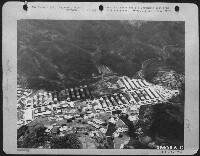 |
Prisoner of War Camp in Nagasaki, Japan. [Emukae?] |
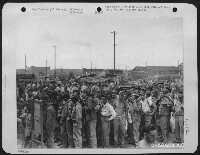 |
Prisoners of war at the dock area in Yokohama, Japan, waiting to be processed prior to boarding a hospital ship. September 1945. |
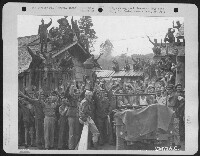 |
Prisoners of war who have been interned in the Hanawa Prisoner of War Camp #6 at Honshu, Japan, joyously greet 1st Lt. Jack Bresnick of Boston, Massachusetts, the first American they have seen in three or four years. 14 September 1945. |
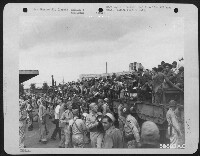 |
Released prisoners of war climbing on trucks at Yokohama Station, Japan, to go to dock area and board hospital ship. September 1945. |
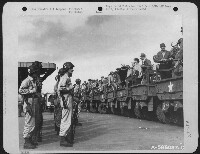 |
Released prisoners of war on trucks at Yokohama Station, Japan, before leaving for the dock area to board hospital ship. September 1945. |
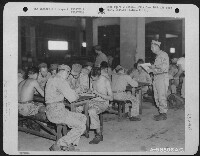 |
Released prisoners of war being processed by Recovered Personnel Team Number 68 at Yokohama Docks before boarding hospital ship. Japan, September 1945. |
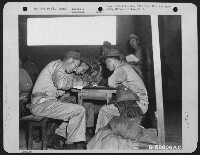 |
Released prisoners of war being processed by Recovered Personnel Team Number 68 at Yokohama Docks before boarding hospital ship. Japan, September 1945. |
 |
Released prisoners of war being processed by Recovered Personnel Team Number 68 at Yokohama Docks before boarding hospital ship. Japan, September 1945. |
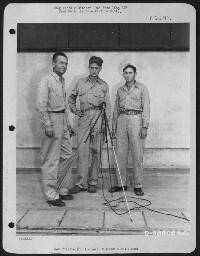 |
Released prisoners of war with interviewer during newsreel production at Yokohama, Japan. September 1945. |
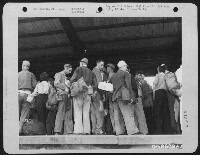 |
Released prisoners of war on the station platform of the Yokohama railroad station, Japan. September 1945. |
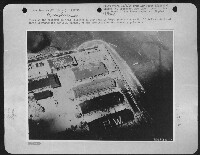 |
Signs on the rooftops of this Prisoner of War Camp in Tokyo-Yokohama-Area No. 15 [Omori] left no doubt of their identity for our B-29 airmen, or the gratitude of the starving prisoners. |
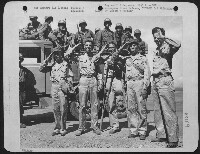 |
The former Jap prisoners walked and hitch-hiked a distance of 550 miles from a camp near Kobe to Atsugi Airdrome. Total time was about 22 hours. They were taken prisoner at Corregidor 26 November 1942. Left to right: Pfc. William Sutherland of Clentinwood, Va.; Petty Officer 3rd Class E. M. Burnett of Memphis, Tenn.; Sgt. Dave A. Granger of Bellingham, Wash., on crutches; Cpl. Edward Hayden of Chicago, Ill.; and Pfc. James Morris of Carlsbad, New Mexico. |
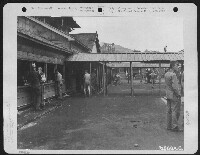 |
The mess hall (left) inside the Hanawa Prisoner of War Camp #6 at Honshu, Japan was stocked with U.S. Army 10 in 1 rations after the Allied troops took possession and released the internees. 14 September 1945. |
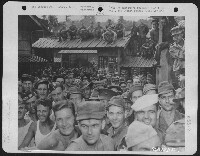 |
Their faces express the emotions of these overjoyed G.I.'s for they now know their dark days in the Hanawa Prisoner of War Camp #6 at Honshu, Japan have come to an end as they feast their eyes upon the first Americans they have seen in three or four years. 14 September 1945. |
 |
Three men who were interned at the Hanawa Prisoner of War Camp #6 at Honshu, Japan pose for the photographer. They are, left to right: George R. Overley, 1836 N. 15th St., Lafayette, Indiana; Wilson Devoss, RR 6, also of Lafayette, Indiana and William L. Vice of Oxford, Indiana. 14 September 1945. |
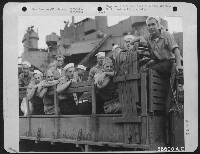 |
Truck in Yokohama, Japan, loaded with released prisoners of war. September 1945. |
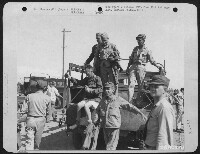 |
Truck load of American prisoners of war arriving at dock area in Yokohama, Japan, to be processed prior to boarding hospital ship. September 1945. |
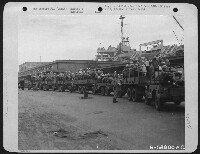 |
Trucks in Yokohama, Japan, loaded with released prisoners of war. September 1945. |
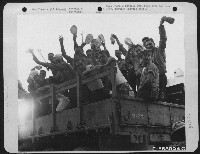 |
Trucks in Yokohama, Japan, loaded with released prisoners of war. September 1945. |
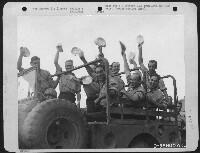 |
Trucks in Yokohama, Japan, loaded with released prisoners of war. September 1945. |
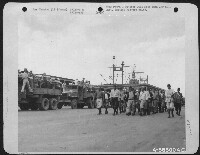 |
Trucks in Yokohama, Japan, loaded with released prisoners of war. September 1945. |
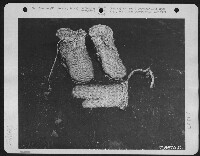 |
Woven shoes and gloves of this type were preferred by the internees over regular G.I. shoes and gloves to protect their hands and feet from the cold winter air as they walked to the copper mine from the Hanawa Prisoner of War Camp #6 at Honshu, Japan. 14 September 1945. |
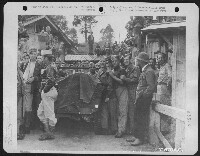 |
Lt. Jack Bresnick talks with men who have been interned at the Hanawa Prisoner of War Camp #6 at Honshu, Japan. Lt. Bresnick is the first American the "POW's" have seen in three or four years. 14 September 1945. |
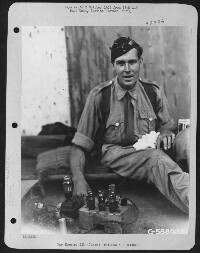 |
Lt. Paul Burrough of Oxford, England, of the Royal Signal Corps. Lt. Burrough was directly responsible for the safe keeping of the only radio in Prisoner of War Camp #13 [Omi]. Yokohama, Japan. September 1945. |
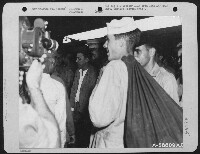 |
Lt. General Robert Eichelberger with prisoners of war on the station platform of Yokohama railroad station, Japan. September 1945. |
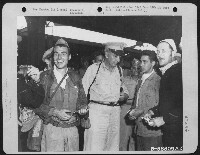 |
Lt. General Robert Eichelberger with prisoners of war on the station platform of Yokohama railroad station, Japan. September 1945. |
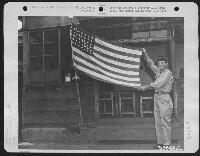 |
John Howton of Edinburg, Texas holds the American Flag he made for the Hanawa Prisoner of War Camp #6 at Honshu, Japan from drop parachutes. 14 September 1945. |
 |
Lt. General Robert Eichelberger meets the released prisoners of war on the station platform of Yokohama railroad station, Japan. September 1945. |
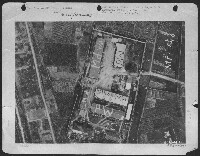
|
Japan. PW camps are plainly labeled for 20th Air Force Superforts searching to drop parcels of food and clothing. (Camp unidentified.) |
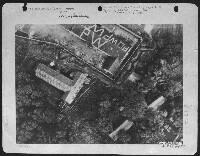 |
Japan. PW camps are plainly labeled for 20th Air Force Superforts searching to drop parcels of food and clothing. (Camp unidentified.) |
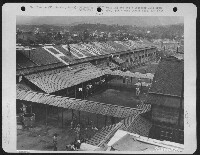 |
General view of the Hanawa Prisoner of War Camp #6 in Honshu, Japan. Note the "POW" markings and the parachutes, which were of various colors, placed on the roof of a building to signify their location to Boeing B-29 crews who dropped supplies to the internees. 14 September 1945. |
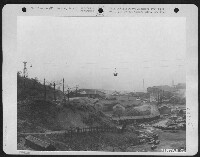 |
General view of the Hanawa Prisoner of War Camp #6 in Honshu, Japan. 14 September 1945. |
 |
Gate to Hanawa Prisoner of War Camp #6 in Honshu, Japan with prisoners waving in the background. 14 September 1945. |
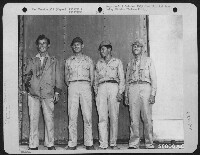 |
Four released prisoners of war. Left to right: Damen E. Alberta, Greensboro, N.C.; Gaylor S. Walker, Trumann, Arkansas; Lester L. Ritch, Pacobt Mills, S.C.; and Mike Sofranoff, 1917 Mass St., Gary, Indiana. Yokohama, Japan, September 1945. |
 |
Dutch Field Artillery war prisoner, Sgt. Peter Sma from Jaffa, Surabaya, receiving his first cup of coffee. Yokohama, Japan. September 1945. |
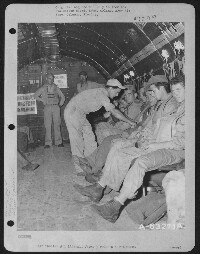 |
Crew Chief "checks" the safety belts of Prisoners of War just prior to take-off. Atsugi, Japan. 8 September 1945. |

|
Concrete water causeway taken from outside the Hanawa Prisoner of War Camp #6 in Honshu, Japan. 14 September 1945. |
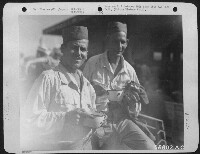 |
British soldiers that owned and operated the only radio in Prisoner of War Camp #13 [Omi]. Yokohama, Japan. September 1945. |
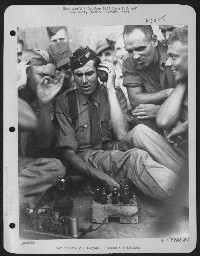 |
British soldiers of the Royal Signal Corps, that owned and operated the only radio in Prisoner of War Camp #13 [Omi]. Yokohama, Japan. September 1945. |
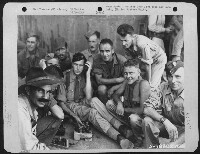 |
British soldiers o the Royal Signal Corps, that owned and operated the only radio in Prisoner of War Camp #13 [Omi]. Yokohama, Japan. September 1945. |
 |
American negro prisoner of war, Abraham Fiye from 137 W. 136 St., N.Y.C., who was imprisoned at Camp #6. He is shown here at the dock area of Yokohama, waiting to board a hospital ship. September 1945. |
 |
American Army nurse, Lt. Eleanor Pope, from Girard, Ohio, of the 42nd General Hospital, greets an American prisoner of war, Cpl. Orman Jacques, from Glendale, Calif., who was imprisoned at Toyama Camp #7. Dock area, Yokohama, Japan. September 1945. |
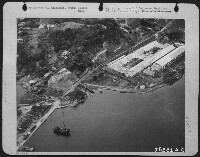 |
A Prisoner of War camp [Fukuoka #2 Koyagi] just south of Nagasaki, Japan. A flag believed to be Dutch was seen at this camp. |
 |
A group of Allied
officers who were
appointed officers at the Hanawa Prisoner of War Camp #6 in Honshu,
Japan. 14 September 1945. They are, front row, left to right: Capt. Dan Golenternek, Los Angeles, Calif.; Lt. Col. Authur J. Walker, % Adj. General, Washington, D.C.; Capt. E.P. Fleming, Jr., 234 Shelburne Rd., Ashville, N.C.; Capt R.G.H. Eagle, R.E., % Lloyds Bank Ltd., London, England; Back row, left to right: Flight Lt. Robert H. Thompson, % RAAF Hdqs., Melbourne, Australia; Capt. T.G. Spotte, 516 Rampart, Los Angeles, Calif.; Lt. W.F. Willoughby, R.E., % Lloyds Bank, London, England; Lt. R.T. Pullen, Jr., 4360 Lime Ave., Long Beach, Calif.; Lt. John E. Lamy, 500 S. Grand Ave., Sedalia, Missouri. |
 |
A crew member of a Douglas C-54 checks his passenger list as Prisoners of War board the plane. Atsugi, Japan. 8 September 1945. |
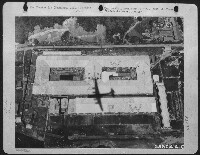 |
A Boeing B-29 passes over Allied Prisoner of War Camp [Fukuoka #2 Koyagi] near Nagasaki, Japan. |
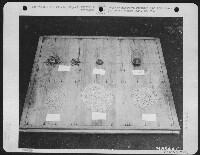 |
Ordinary rations which each internee received daily at the Hanawa Prisoner of War Camp #6 in Honshu, Japan. 14 September 1945. |
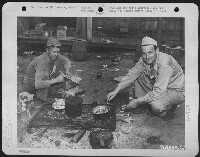 |
N. Wallace, Box 718, Holtville, California and Jack N. Warnick, 284 - 26th Ave., San Francisco, California cook their first G.I. meal since they were released from the Hanawa Prisoner of War Camp #6 in Honshu, Japan. 14 September 1945. |
Recovery Team #56 Documents |
|
| POW_Recovery_Status_Report_1945-09-22 POW_Recovery_Team_56_Summary_1945-10-03 Allied POW and Civilian Internee rosters (not in alphabetical order): POW_Recovery_Yokohama_Docks_1945-09-05
POW_Recovery_Yokohama_Docks_1945-09-06 POW_Recovery_Yokohama_Docks_1945-09-07 POW_Recovery_Yokohama_Docks_1945-09-08 POW_Recovery_Yokohama_Docks_1945-09-09 POW_Recovery_Yokohama_Docks_1945-09-10 POW_Recovery_Yokohama_Docks_1945-09-11 POW_Recovery_Yokohama_Docks_1945-09-16 POW_Recovery_Yokohama_Docks_1945-09-18 POW Camp Reports: POW_Recovery_TOK-MAIN_Omori_1945-09-25
POW_Recovery_TOK-MAIN_DET_Ofuna_1945-09-23 POW_Recovery_TOK-1-B_Kawasaki_1945-09-22 POW_Recovery_TOK-2-B_Kawasaki_1945-09-22 POW_Recovery_TOK-3-B_Yokohama_Park_1945-09-23 POW_Recovery_TOK-14-B_Yokohama_1945-09-24 POW_Recovery_TOK-17-B_Yokohama_1945-09-28 POW_Recovery_TOK-1-D_Yokohama_1945-09-26 POW_Recovery_TOK-3-D_Yokohama_1945-09-28 POW_Recovery_TOK-5-D_Kawasaki_1945-09-27 POW_Recovery_TOK-9-D_Kawasaki_1945-09-27 POW_Recovery_TOK-10-D_Yokohama_1945-09-28 POW_Recovery_TOK-13-D_Yokohama_1945-09-24 POW_Recovery_TOK-18-D_Yokohama_1945-09-27 POW_Recovery_TOK-19-D_Yokohama_1945-09-26 POW_Recovery_TOK-23-D_Kawasaki_1945-09-25 POW_Recovery_TOK-24-D_Kawasaki_1945-09-25 |
|